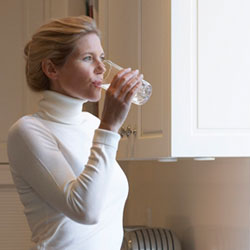I saw this on the Shaklee website and thought it was worth sharing in honor of Earth Day and while we wait patiently, (not!) for Spring to arrive.
Why Water?
 |
Everyone
knows that water is essential to life. But what's coming out of your
tap or bottle may not really be your healthiest choice.
|
The Real Dirt on Clean Water
Sure, your water may look clean but is it?Most people think that governmental agencies ensure that our water's clean. And while the Environmental Protection Agency (EPA) established the Clean Water Act to safeguard our water supply, it only set standards and testing requirements in our municipal water treatment facilities for 114 different contaminants out of literally hundreds more.
In fact, the Environmental Working Group obtained test results from a database of over 20 million records from state water officials to determine the quality of drinking water in 45 states. The results revealed 316 contaminants were present in our water supplies. Among them were 202 chemicals that aren't regulated by any safe water standards.i
Checking the quality of your local water is easy to do. Just visit the National Drinking Water Database.
So yes, your water looks clean. But really, it's not.
Why Filtration?
The simple answer? You either use a filter or you are the filter. Only 2% of all treated water is used for drinking water. The rest is used on your lawn, shower, laundry, or used for farms or industry. It's simply too time-consuming and expensive to test and remove the thousands of chemicals that may be present in any particular water source.
And even if your water was perfectly clean before it left your municipality, it still has miles to travel in pipes before it gets to your home. Who knows what it runs into along the way?
What are you really drinking?
Here's what may be in your water, and some of its hazardous effects:
Industrial Pollutants (such as benzene, nitrates, and petrochemicals): Long-term exposure may cause increased risk of cancer, as well as blood, nervous system, kidney, and liver problems.
Agricultural Pollutants (pesticides such as atrazine, lindane, alachlor, and others): Long-term exposure may cause increased risk of cancer, as well as eye, liver, kidney, spleen, blood, and nervous system problems.
Heavy Metals (such as lead, copper, mercury, arsenic, and cadmium): Even at low levels, long-term exposure may cause behavioral problems and learning disabilities. The EPA estimates that between 10 and 20% of total lead exposure in young children comes from drinking water.ii
Disinfection By-products (such as: trihalomethanes, chloroform, bromodichloromethane, dibromochloromethane,and bromoform): Long-term exposure may cause increased risk of cancer, as well as liver, kidney, or central nervous system problems.
With all these problems with tap water, you might think that bottled water is the answer—but you're wrong. What most people don't know is that there're no regulations regarding the quality of bottled water. That's right, none. Bottling companies don't even have the same regulations to follow that your local municipal water supply does. That means that despite the clean look of your bottle, in many cases the water it contains isn't any better than tap water.
The bottom line is that you can't control what happens to your water before it gets to your house. But you can control what happens after. If you want to make sure you have really clean drinking water, you really have to use a filter—a good one.
|
|
|
|
|
Why Get Clean® Water?
Because it's safe, powerful, green and smart—and it outperforms both Brita® and PUR®*, hands-down:- Safe It reduces 59 harmful contaminants—at least 21 of which Brita doesn't even touch—including up to 99% of water-borne lead.
- Powerful It's incredibly thrifty, delivering over 80 gallons of purer water from every hardworking, environmentally friendly filter—twice as much as big-name brands—for just a little over a penny per glass**.
- Green It uses a unique refillable filter system, so there's less waste in landfills.†
- Smart It features a convenient smart-meter that shows you exactly when to replace your filter, so there's no more guessing. And on top of all that, it's 'Gold Seal' certified to tough ANSI/NSF Standards 42 and 53 by the Water Quality Association (WQA).

